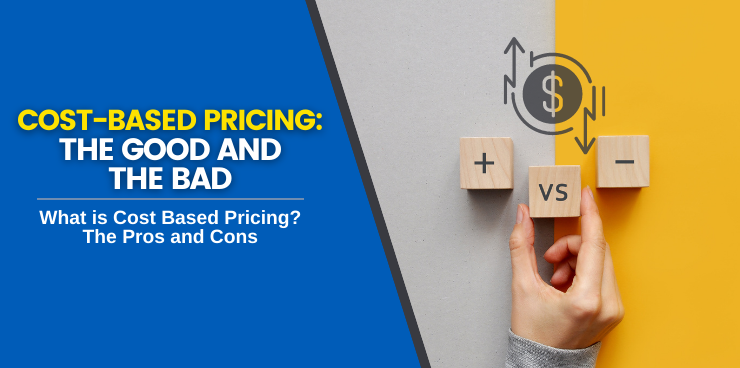The last thing any business wants is to fizzle out due to a lack of customers and revenue. And for many businesses, this happens because they’re not charging enough for their products or services.
This is where cost-based pricing comes in.
As a home service business, you must be strategic when it comes to pricing your products and services. When you do, it will be easier to not only attract new customers but also keep the ones you’ve already got.
So, what exactly is cost-based pricing, and how do you know if it’s the right pricing strategy for your business?
In this article, we’ll explore this type of pricing strategy in detail, including its advantages and disadvantages, so that you can make an informed decision about whether or not it’s the right pricing strategy for your business.
What Exactly is Cost-Based Pricing?
Cost-based pricing, otherwise known as the cost-plus method, is a pricing strategy for goods and services that takes into account the cost of producing and delivering them. Businesses use cost-based pricing to calculate a price that will cover their costs and allow them to make a profit.
This allows businesses to stay ahead of the competition by making sure they are not selling their products or services at a loss. Many businesses use cost-based pricing in conjunction with other pricing strategies to come up with a final price for their goods and services.
There are several different methods of cost-based pricing, but all of them involve considering the cost of making and selling a product or service before setting the price. This ensures that prices are fair and reasonable and that businesses can stay in operation.
Are you seeking a more optimized pricing strategy for your business?
At Wizard of Sales®, we help businesses in the home service industry find a more efficient and effective approach to pricing and negotiation. Our Hybrid Pricing Model™ allows you to implement authentic and persuasive pricing that enhances profitability.
Book a demo with us today to get started!
The Two Methods of Cost-Based pricing
Cost-based pricing can be broken down into two main types: cost-plus pricing and break-even pricing.
Cost-plus pricing
In the cost-plus method, businesses add a markup to the cost of their goods or services to make a profit. The cost-plus method is often used by businesses when they are trying to price new products.
To calculate cost-plus pricing, businesses first need to determine all the costs associated with producing their goods or services. These costs can include:
- Raw materials
- Labor
- Manufacturing overhead
After all the costs have been tallied up, a markup is added to the total cost. The markup can be a percentage of the cost or a flat fee. Once the cost-plus markup has been determined, that is the price charged to the customer.
Break-even pricing
Break-even pricing is a method in which the company sets the price of its product or service so that it covers all of its costs and makes a profit.
To calculate break-even pricing, businesses need to determine their fixed costs, variable costs, and desired profit. Fixed costs are expenses that stay the same regardless of how many products or services are sold, such as rent and utilities. Variable costs are expenses that change based on how many products or services are sold, such as the cost of materials.
Once businesses have determined their fixed and variable costs, they can calculate their break-even point — the number of products or services they need to sell to make a profit. From there, they can add their desired profit to their break-even point to determine their cost-based price.
Pros of Cost-Based Pricing
Cost-based pricing has several great advantages. Here are the top three to consider when deciding if cost-based pricing is the best method for your business:
Easy to Calculate
One of the main advantages of cost-based pricing is that it is relatively easy to calculate. You simply take your total costs and add the desired profit margin. This makes cost-based pricing ideal for businesses with low margins or high fixed costs.
Ensures a Steady Rate of Profit
Another big advantage of cost-based pricing is that it ensures a steady rate of profit. Because you are always aiming to cover your costs plus make a profit, cost-based pricing helps to ensure that your business remains profitable, even if sales volume fluctuates.
Customers Find it Rather Simple to Understand
Cost-based pricing can be easy for customers to understand. If they know how much it cost you to produce the product, then they can better understand why you charge what you do. In some cases, cost-based pricing may even help increase customer loyalty because they feel that they are being charged a fair price.
Cons of Cost-based Pricing
Just as cost-based pricing has its advantages, it also has its fair share of disadvantages that should be considered before implementing this type of pricing strategy.
Demand or Competition Are Not Considered in Cost-Based Pricing
In cost-based pricing, the selling price is set based on the cost of producing the good or service, without considering demand-based pricing or competition. This can sometimes lead to prices that are too high or too low, depending on the market conditions.
Variation in Prices in Comparison to the Target Market
If the cost of producing a good or service varies widely, cost-based pricing can result in prices that are all over the map. This can be confusing for customers and make it difficult to establish a consistent brand identity because prices are constantly changing.
Could Lead to an Inefficient and Unethical Production Process
If cost-based pricing is the only thing considered when setting prices, there’s no incentive to find ways to produce goods or services more efficiently. This could lead to an unethical production process that is wasteful and harmful to the environment or takes advantage of workers.
 Cost-Plus Pricing Strategy Example
Cost-Plus Pricing Strategy Example
To paint a better picture, let’s do a cost-based pricing example for an HVAC company. Let’s say this company offers installation, repair, and maintenance services for air conditioning and heating units. They have a team of highly trained technicians that are available 24/7.
The company’s cost-plus pricing strategy takes into account all the costs associated with providing its services. This includes the cost of labor, materials, overhead, and any other expenses incurred in running the business. The company then adds a markup to this cost to generate a price for its services.
For example, let’s say it costs the HVAC company $100 to provide a service. They may then add a 20 percent profit markup to this cost, resulting in a price of $120 for the customer. The final price may also be affected by discounts, special offers, or other factors such as competition.
Now, that this HVAC company has a cost-plus pricing strategy in place, it can be sure that it is always covering its costs and making a profit. This type of pricing can be helpful for businesses that have high overhead costs or that need to price their services quickly and without much market research.
Cost-Plus Price Formula
The cost-plus pricing formula is as follows:
cost-plus price = cost [(mark up/100) X cost]
To use the formula, you need to know your cost and the desired markup percentage. The markup is the gross profit you want to earn on the product or service and is expressed as a percentage of the cost.
For example, if your cost is $100 and you want to earn a 50 percent gross profit, your markup would be 50. Once you have those numbers, you simply plug them into the formula like this:
$ cost-plus price = cost [(mark up/100) X cost]
$ 100 cost-plus price = 100 [(50/100) X 100]
$ cost-plus price = $150
As you can see, the cost-plus price would be $150.
With this formula, it’s easy to calculate a cost-plus price for any product or service. Just remember to use the right cost figure. For manufactured products, that would be the cost of direct materials, direct labor, and overhead. For services, it would be the cost of direct labor and overhead.
 Is Cost-Based Pricing Right for You?
Is Cost-Based Pricing Right for You?
Cost-based pricing can be a useful tool for setting prices, but it’s not the only option. Other methods such as value-based pricing or market-based pricing may be more suitable for your business. So how do you know which approach is best for you?
Start by evaluating your business’s unique selling proposition (USP). What is it that makes your product or service special? What value do you provide that your competitors don’t? Answering these questions can help you determine the perceived value pricing of your offering and decide which method works best.
If your product is truly unique and there’s no market for it, then cost-based pricing may be the best option. However, if other businesses are offering similar products or services, market-based pricing is likely a better approach.
Deciding your pricing strategy is a big deal. After all, it will have a direct impact on your bottom line. But don’t let that intimidate you. By taking the time to understand the different options and evaluate what makes sense for your business, you can develop a pricing strategy that works for you.
At Wizard of Sales®, we can make your pricing strategy development process easy. Our Hybrid Pricing Model™ fits perfectly with a consultive style of selling, discounting, and negotiation that resonates at the kitchen table, helping make it easier for your sellers to sell, and your buyers to buy on the first sit.
Want to know more? Book a demo with us today!



 Cost-Plus Pricing Strategy Example
Cost-Plus Pricing Strategy Example Is Cost-Based Pricing Right for You?
Is Cost-Based Pricing Right for You?